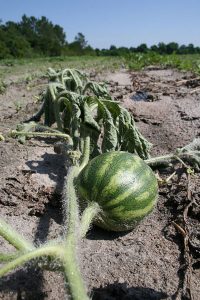By Clint Thompson
A costly but effective option for watermelon producers hoping to overcome fusarium wilt disease is the use of Carolina Strongback rootstock.

Bhabesh Dutta, University of Georgia Extension vegetable pathologist, spoke about the rootstock during the Southeast Regional Fruit and Vegetable Conference. He talked about its success in research trials on the UGA Tifton Campus.
“This is our fourth year of trials with Carolina Strongback. It’s performing quite consistently across fields that have a history of fusarium wilt,” Dutta said. “I would say it is not completely resistant to fusarium, but it is tolerant of fusarium. It can tolerate the infection of fusarium.
“Is it affordable? No, but if a grower doesn’t have any choice and he knows he has a field heavily infested with fusarium and he intends to grow his melons, he can think about that (option). Otherwise, if you have a low level of infestation, I think you can get by with Proline or Miravis Prime.”
Fusarium wilt symptoms can appear at any growth stage. If they appear at the seedling stage, the plants will not even make it to vines. Plants infected with the pathogen will eventually die if the infection is severe. The plant can produce fruit if the infection is not as strong, but when it begins using the energy necessary to produce fruit, the plant will likely decline and slowly die.
Watermelon plants can become infected in multiple ways. The pathogen can produce spores that survive in the soil, be seedborne and introduced to fields where watermelons have never been produced before.
Dutta emphasized previously that it is vital for growers to check their seedlings before planting for any type of wilting symptoms associated with fusarium wilt. This will help producers not to further introduce the inoculum in the field.









